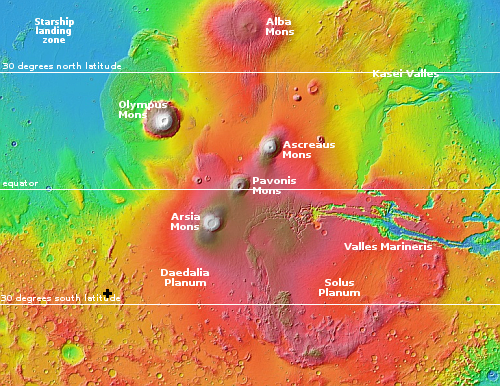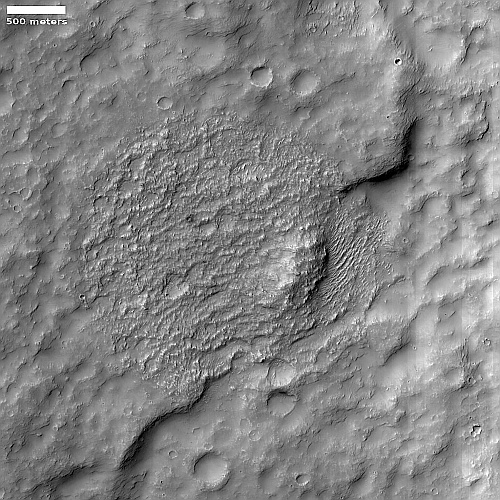A rash on Mars
Cool image time! The picture to the right, rotated, cropped, reduced, and sharpened to post here, was taken on January 30, 2023 by the high resolution camera on Mars Reconnaissance Orbiter (MRO). The science team labeled this a “Circular Outcrop of Bright Rock.
What I see is a Martian skin rash. Based on the ripple pattern below the ridge one might think we are looking at sand dunes, except that the rash above the cliff has no such pattern. Instead, the ground in this one particular area looks very roughened in a random sort of way.
The location at 27 degrees south latitude suggests there is little near surface ice at this location to cause this feature. The overview map below provides another but not very helpful possibility.

The black cross west of Daedalia Planum marks this location, just beyond the main flood lava plains that surround Mars’ biggest volcanoes on the Tharsis Bulge. This particular area is also covered extensively with lava, but the many north-south ridges suggest wrinkle ridges that rose up when the surface contracted at some point in the past.
Another possible cause of the ridges would be lava dikes, where lava flows up through a fissure.
Either way, the flowing of lava might have had something to do with this rash, but I certainly cannot come up with any theory to explain it. We need a real planetary geologist for that.
On Christmas Eve 1968 three Americans became the first humans to visit another world. What they did to celebrate was unexpected and profound, and will be remembered throughout all human history. Genesis: the Story of Apollo 8, Robert Zimmerman's classic history of humanity's first journey to another world, tells that story, and it is now available as both an ebook and an audiobook, both with a foreword by Valerie Anders and a new introduction by Robert Zimmerman.
The print edition can be purchased at Amazon or from any other book seller. If you want an autographed copy the price is $60 for the hardback and $45 for the paperback, plus $8 shipping for each. Go here for purchasing details. The ebook is available everywhere for $5.99 (before discount) at amazon, or direct from my ebook publisher, ebookit. If you buy it from ebookit you don't support the big tech companies and the author gets a bigger cut much sooner.
The audiobook is also available at all these vendors, and is also free with a 30-day trial membership to Audible.
"Not simply about one mission, [Genesis] is also the history of America's quest for the moon... Zimmerman has done a masterful job of tying disparate events together into a solid account of one of America's greatest human triumphs."--San Antonio Express-News
Cool image time! The picture to the right, rotated, cropped, reduced, and sharpened to post here, was taken on January 30, 2023 by the high resolution camera on Mars Reconnaissance Orbiter (MRO). The science team labeled this a “Circular Outcrop of Bright Rock.
What I see is a Martian skin rash. Based on the ripple pattern below the ridge one might think we are looking at sand dunes, except that the rash above the cliff has no such pattern. Instead, the ground in this one particular area looks very roughened in a random sort of way.
The location at 27 degrees south latitude suggests there is little near surface ice at this location to cause this feature. The overview map below provides another but not very helpful possibility.

The black cross west of Daedalia Planum marks this location, just beyond the main flood lava plains that surround Mars’ biggest volcanoes on the Tharsis Bulge. This particular area is also covered extensively with lava, but the many north-south ridges suggest wrinkle ridges that rose up when the surface contracted at some point in the past.
Another possible cause of the ridges would be lava dikes, where lava flows up through a fissure.
Either way, the flowing of lava might have had something to do with this rash, but I certainly cannot come up with any theory to explain it. We need a real planetary geologist for that.
On Christmas Eve 1968 three Americans became the first humans to visit another world. What they did to celebrate was unexpected and profound, and will be remembered throughout all human history. Genesis: the Story of Apollo 8, Robert Zimmerman's classic history of humanity's first journey to another world, tells that story, and it is now available as both an ebook and an audiobook, both with a foreword by Valerie Anders and a new introduction by Robert Zimmerman.
The print edition can be purchased at Amazon or from any other book seller. If you want an autographed copy the price is $60 for the hardback and $45 for the paperback, plus $8 shipping for each. Go here for purchasing details. The ebook is available everywhere for $5.99 (before discount) at amazon, or direct from my ebook publisher, ebookit. If you buy it from ebookit you don't support the big tech companies and the author gets a bigger cut much sooner.
The audiobook is also available at all these vendors, and is also free with a 30-day trial membership to Audible.
"Not simply about one mission, [Genesis] is also the history of America's quest for the moon... Zimmerman has done a masterful job of tying disparate events together into a solid account of one of America's greatest human triumphs."--San Antonio Express-News



Robert,
The text in the overview map probably should read “Starship landing zone.” I think you have a minor typo.
Perhaps the circularity of the “rash” means something (allergies?). It follows the topography of the terrain, covering rises and hills as well as dips, and many or most of the crater features are also filled with the rash, which suggests to me that the rash may be a relatively new feature, geologically speaking. There are quite a few craters in the surrounding area, suggesting that the general terrain is not young.
These cool images of Mars, a couple of hundred per year, show us that once mankind gets there, we will have so very much exploration to do.
Edward: Thank you. Error in overview map has been fixed.